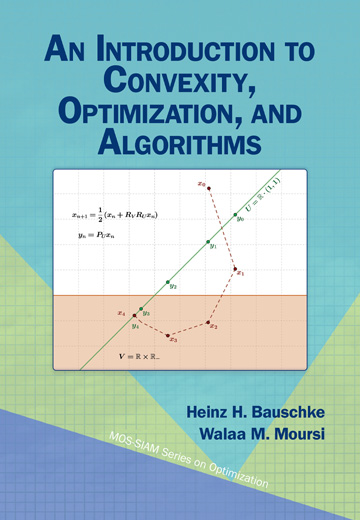
- Author: Heinz H. Bauschke & Walaa M. Moursi
- Series: MOS-SIAM Series on Optimization
- Publisher: SIAM
- Publication Date: 12/20/2023
- Number of Pages: 191
- Format: Paperback
- Price: $60.00
- ISBN: 978-1-61197-779-0
- Category: textbook
[Reviewed by Bill Satzer, on 11/13/2024]
The authors’ goal in this book is to describe the basics of convex analysis, convex optimization, and the algorithms they enable. Convex optimization looks at the question of minimizing a convex function over a convex set. This study has ramifications across many disciplines of applied mathematics. Algorithms for convex optimization have become very important for a broad class of problems, and also have a big part in many machine learning applications.
The book is largely self-contained, according to the authors, is accessible with a basic background in calculus, linear algebra, and analysis, and is appropriate for advanced undergraduates and beginning graduate students.
The approach is to proceed by developing the basis of convex analysis piece by piece and then moving on to tie these results to optimization and then algorithms for convex optimization. Exercises are provided at each stage.
The highlights of the book are its treatment of some innovative algorithms – proximal gradient and Douglas-Rachford, for example – that have current applications in signal processing and machine learning.
The authors’ preface suggests that this book could be “completely read ..., in a relatively short… period of time”, cover-to-cover. Yet this reviewer did not find it an easy read. The first indication was on the first page of Chapter 1 with Proposition 1.1. It is long and dense and needs to be carefully parsed. This would be a difficult read for a reader with the minimal background and seems an unnecessarily dense and complicated way of conveying some necessary basic background.
Even more of a concern is the way that the authors proceed from topic to topic and chapter to chapter without giving the reader much of a sense of where they’re going, how one section leads to another, or why the topics fit together. The book needs a narrative thread. While the sequence of pieces does eventually all converge, it requires more than a little prior expertise for the reader to follow their development.
All the material the authors intend is indeed present in the book, but working through it is not the enjoyable experience that they suggest.
Bill Satzer (bsatzer@gmail.com), now retired from 3M Company, spent most of his career as a mathematician working in industry on a variety of applications. He did his PhD work in dynamical systems and celestial mechanics.
